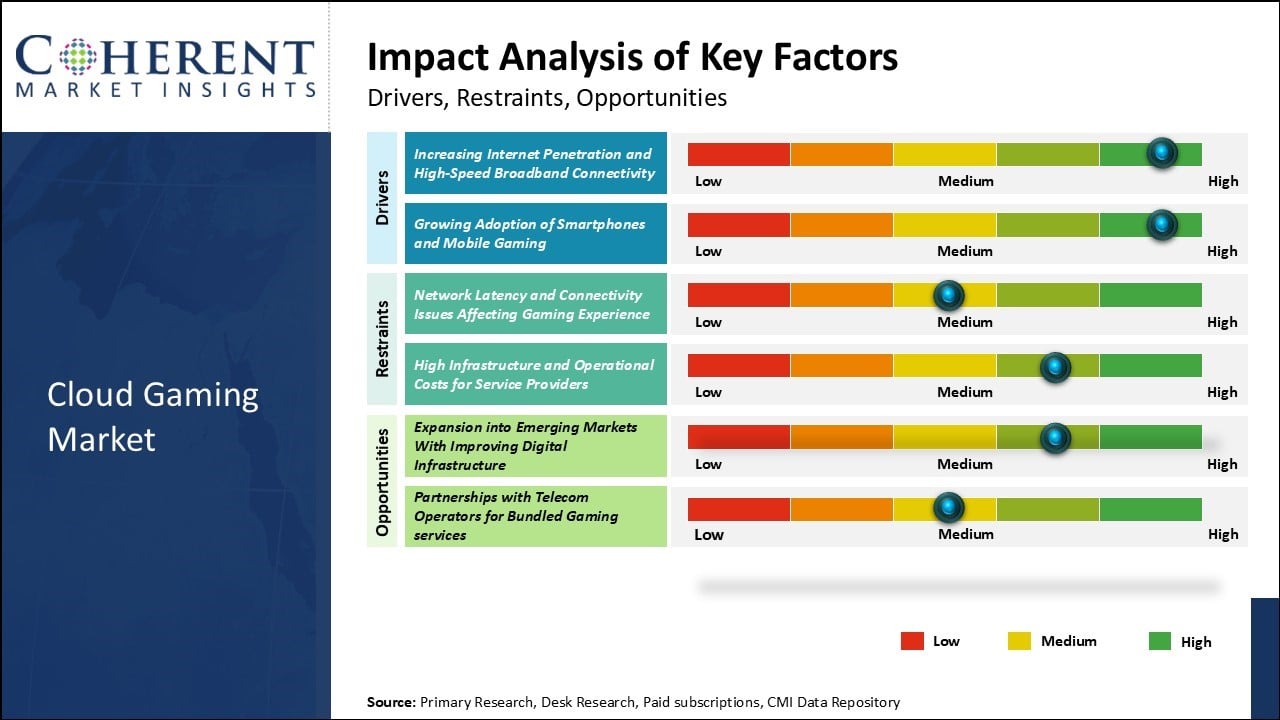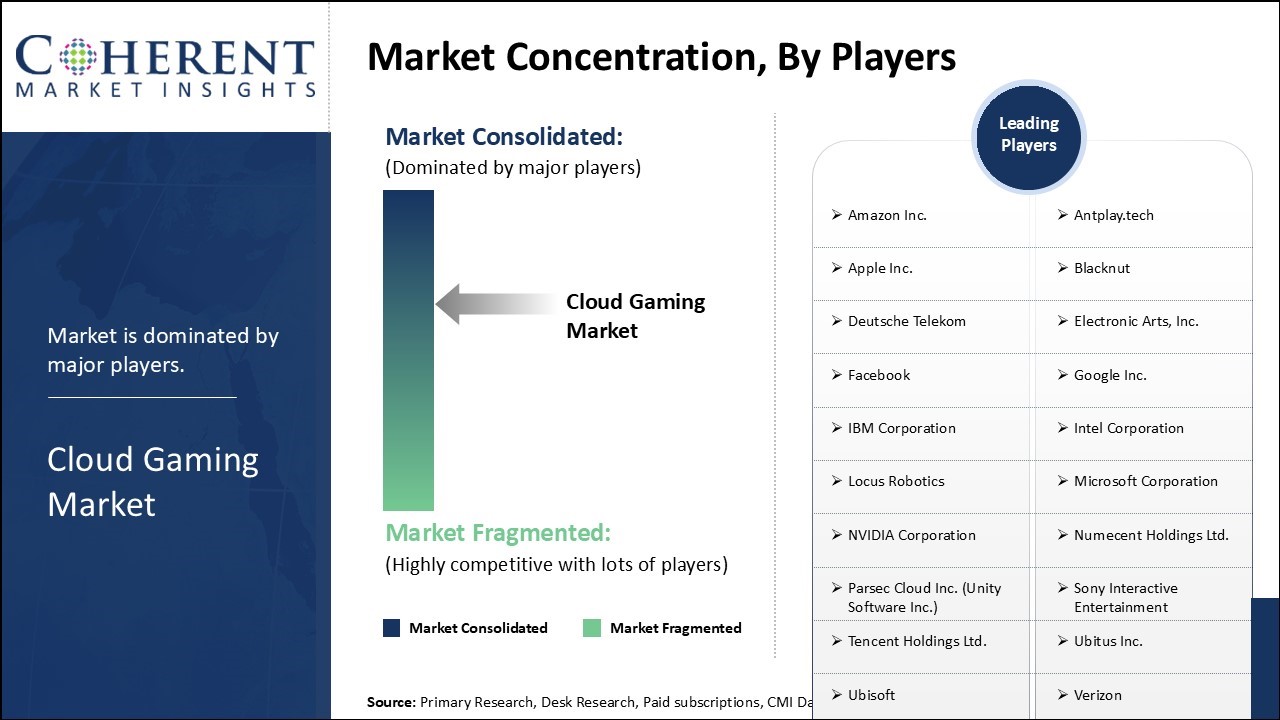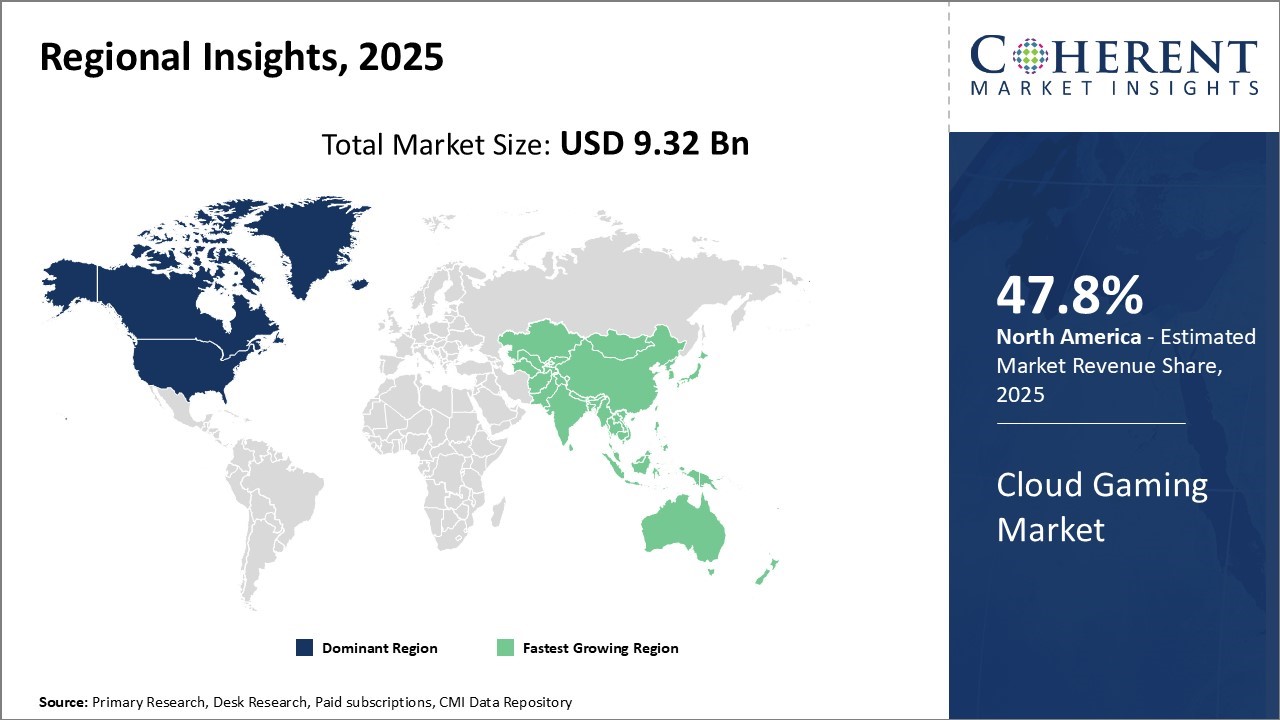Cloud gaming market is estimated to be valued at USD 9.32 Bn in 2025 and is expected to reach USD 159.24 Bn by 2032, exhibiting a compound annual growth rate (CAGR) of 50.0% from 2025 to 2032.

To learn more about this report, Download Free Sample
The high-speed internet and increasing adoption of game streaming services can drive the market growth. Major players are focused on improving their infrastructure and expanding into new regions to capitalize on the opportunity. Upgrade of 5G network globally is projected to enhance the overall experience for end users.
However, lack of awareness about cloud gaming in some parts of the world and concerns around data security and privacy can hamper the market growth. The development of affordable cloud gaming devices and lowering internet prices can offer new opportunities in the near future.

To learn more about this report, Download Free Sample
|
Current Events |
Description and its impact |
|
5G Network Infrastructure Expansion and Deployment |
|
|
U.S.-China Technology Trade Tensions and Export Controls |
|
Uncover macros and micros vetted on 75+ parameters: Get instant access to report
The increasing consumer appetite for premium gaming experiences, coupled with the prohibitive costs of high-end gaming hardware, has fundamentally transformed the gaming landscape and positioned cloud gaming and mobile gaming as compelling alternatives. In emerging markets like Latin America, for example, mobile gaming is surging — driven by the affordability and accessibility of smartphones.
For instance, according to the Games Forum, in 2024, LATAM saw installs grow about 8% and gaming sessions rise 5%–7%, the highest of any region. Cost-per-install rates in Latin America remain extraordinarily low, ranging from USD 0.50 to USD 2.00 — a stark contrast to North America's USD 2–USD 5 — making user acquisition and access to games more affordable than ever.
In terms of type, video streaming segment is estimated to contribute the highest market share of 58.8% in 2025. Video games have become increasingly realistic and complex over the years, demanding high-end graphics and smooth gameplay.
However, many users still have aging hardware or low-specification devices that cannot support these hardware-intensive games locally. This is where cloud gaming through video streaming helps bridge this gap. By offloading the intensive processing to remote data centers, even low-end devices are able to experience console-like AAA games through high-quality video streams. This allows users to enjoy their favorite games anywhere, anytime on a variety of screens from their smartphones to smart TVs.
In terms of device, smartphones segment is estimated to contribute the highest market share of 37.7% in 2025. As gaming becomes more of a pastime activity amid busy schedules, users prefer playing on the go via their phones.
Cloud gaming solves the limitations of traditional mobile games by providing console-quality experiences that can be seamlessly picked up and enjoyed during commutes, breaks, or anytime away from dedicated devices. This appeals greatly to both casual gamers looking to kill time and hardcore players who want their favorite AAA franchises on a mobile form factor.
In terms of gamer type, casual gamers segment is estimated to contribute the highest market share of 77.8% in 2025. This segment comprises individuals who enjoy games primarily as a casual pastime or for their entertainment value rather than hardcore gameplay.
These people prefer titles with lower commitment barriers that can be easily picked up during brief leisure windows. Cloud streaming addresses this need by removing installation burdens and allowing on-demand access through versatile devices from any location.

To learn more about this report, Download Free Sample
North America has emerged as the dominant region in cloud gaming market with an estimated market share of 47.8% in 2025. With well-established infrastructure and early adoption of advanced technologies, the U.S. and Canada have witnessed rapid growth in cloud gaming subscriptions and revenues. Major cloud gaming providers such as Google Stadia, Microsoft xCloud, and Nvidia GeForce NOW have gained popularity in this region.
For instance, in March 2020, a Verizon network report revealed that gaming usage in the United States had surged by 75% during peak hours, compared to the previous week—highlighting a dramatic shift toward digital and cloud-based gaming platforms as users sought more convenient, hardware-light ways to access games amid the pandemic's early stages.
Asia Pacific is witnessing the fastest growth in the cloud gaming market for the forecast period of 2025-2032. Countries such as China, Japan, and South Korea are aggressively expanding their digital infrastructure to support emerging technologies. With large young demographic cohorts and increasing disposable incomes, this region provides a lucrative market for cloud-based gaming services.
For instance, according to the FICCI EY Report, published on March 27, 2025, the Indian online gaming sector is projected to grow at a compound annual growth rate of 10.8 percent over the next three years, reaching USD 368.7 million by 2027. This rapid expansion in online gaming is expected to accelerate demand for cloud gaming platforms, as consumers seek more accessible and hardware-independent gaming experiences across the Asia Pacific region.
The U.S. leads the global cloud gaming market due to its advanced digital infrastructure, widespread 5G adoption, and a strong ecosystem of technology giants such as Microsoft, Google, Amazon, and NVIDIA. These companies are investing heavily in cloud gaming platforms, leveraging their cloud computing capabilities and massive content libraries. High consumer spending on gaming and a large base of early tech adopters further support the rapid growth and innovation in the U.S. cloud gaming space.
China’s cloud gaming market is expanding rapidly, driven by its large population of mobile gamers, strong government support for digital innovation, and widespread high-speed internet access, including 5G coverage. Leading tech firms such as Tencent and NetEase are developing proprietary cloud gaming services, often integrated with their vast gaming portfolios. Despite facing export restrictions on advanced hardware, China’s domestic investments and focus on AI and edge computing are helping sustain momentum in the sector.
South Korea is a key player in cloud gaming due to its exceptional broadband penetration, tech-savvy population, and government-backed digital infrastructure policies. The country boasts one of the world’s fastest internet speeds, which enables low-latency gaming experiences—a critical requirement for cloud gaming success. South Korea is also home to globally recognized game developers and e-sports organizations, creating a highly supportive environment for the adoption and scaling of cloud gaming services.
Japan remains a strong cloud gaming market, supported by its long-established gaming culture, technological innovation, and rising adoption of subscription-based gaming models. Major gaming companies such as Sony and Nintendo are exploring cloud-based services to extend their reach beyond traditional consoles. Japan's strong mobile gaming ecosystem and early interest in immersive technologies like VR and AR also create fertile ground for cloud gaming platforms to thrive, particularly among younger consumers.
|
Platform |
Approximate Cost (USD) |
|
Google Stadia Pro |
9.99 |
|
NVIDIA GeForce NOW RTX 3080 |
19.99 |
|
Xbox Game Pass Ultimate |
14.99 |
|
PlayStation Plus Premium |
17.99 |
|
Amazon Luna + Ubisoft |
24.98 (Combined) |
Uncover macros and micros vetted on 75+ parameters: Get instant access to report
| Report Coverage | Details | ||
|---|---|---|---|
| Base Year: | 2024 | Market Size in 2025: | USD 9.32 Bn |
| Historical Data for: | 2020 To 2024 | Forecast Period: | 2025 To 2032 |
| Forecast Period 2025 to 2032 CAGR: | 50.0% | 2032 Value Projection: | USD 159.24 Bn |
| Geographies covered: |
|
||
| Segments covered: |
|
||
| Companies covered: |
Amazon Inc., Antplay.tech, Apple Inc., Blacknut, Deutsche Telekom, Electronic Arts, Inc., Facebook, Google Inc., IBM Corporation, Intel Corporation, Locus Robotics, Microsoft Corporation, NVIDIA Corporation, Numecent Holdings Ltd., Parsec Cloud Inc. (Unity Software Inc.), Sony Interactive Entertainment, Tencent Holdings Ltd., Ubitus Inc., and Ubisoft, Verizon |
||
| Growth Drivers: |
|
||
| Restraints & Challenges: |
|
||
Uncover macros and micros vetted on 75+ parameters: Get instant access to report
*Definition: Cloud gaming allows users to stream and play video games hosted on remote servers instead of downloading the entire game file to their local device. Users can access and play high-end video games through an internet connection without needing expensive high-powered gaming PCs or consoles. The games are rendered on cloud servers and the video and input are streamed to any device via the internet, providing users with instant access to play full console- and PC-quality games from anywhere.
Share
Share
About Author
Raj Shah is a seasoned strategy professional with global experience, from strategy to on-the-ground operational improvements. In last 13 years, he has executed number consulting projects focused on consumer electronics, telecom and consumer-internet business leading multiple long-term engagements towards mobilizing and executing on break-through strategy - leading to tangible sales results. Raj is also acting as a strategy consultant for one of the leading online hyper local service providers in India, contributing to their growth through critical strategic decisions. Raj usually spends time after office in talking to the passionate entrepreneurs, regardless of their funding status.
Missing comfort of reading report in your local language? Find your preferred language :
Transform your Strategy with Exclusive Trending Reports :
Frequently Asked Questions
Joining thousands of companies around the world committed to making the Excellent Business Solutions.
View All Our Clients